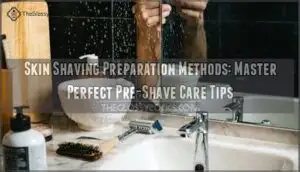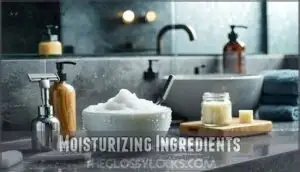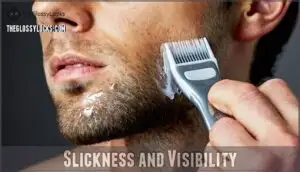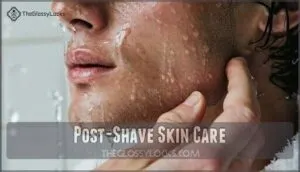This site is supported by our readers. We may earn a commission, at no cost to you, if you purchase through links.

First, wash your skin with warm water—think of it as a wake-up call for your hair. Next, use shaving cream or gel. It’s like buttering bread before toasting.
Always shave with the grain, not against it, or you’ll feel like you wrestled a cactus. Rinse your razor after each swipe.
Finally, keep your razor dry so it doesn’t rust. These steps help you avoid nicks and bumps.
Stick around for tips on exfoliation, secret ingredients, and ways to keep your skin happy long after the shave.
Table Of Contents
- Key Takeaways
- Skin Preparation Methods
- Shaving Techniques Overview
- Exfoliation Best Practices
- Shaving Creams and Gels
- Post-Shave Skin Care
- Frequently Asked Questions (FAQs)
- How to prep your skin before shaving?
- How do you prepare a patient’s skin for shaving?
- What method of shaving is best for skin?
- What are the different types of shaving techniques?
- How often should I replace my razor blades?
- What causes razor burn and bumps exactly?
- Should I shave against or with hair growth?
- What time of day is best for shaving?
- Conclusion
Key Takeaways
- Prep your skin with warm water – Spend 3 minutes softening hair and opening pores with warm water before applying any shaving products, which cuts irritation in half.
- Exfoliate 2-3 times weekly – Remove dead skin cells that trap hairs and create ingrowns, giving your razor a smoother surface to glide across.
- Choose quality shaving products – Use moisturizing creams or natural oils instead of basic soaps, as they provide better lubrication and skin protection during shaving.
- Follow proper post-shave care – Rinse with cool water, apply fragrance-free moisturizer within 2 minutes, and wear loose clothing to prevent friction and irritation.
Skin Preparation Methods
You’ll get the best shave of your life when you prepare your skin properly first.
The right prep work turns a painful daily chore into a smooth, comfortable experience that leaves your skin feeling amazing.
Gentle Cleansing Techniques
Before you shave, gentle cleansing removes dirt, oil, and bacteria that could cause infection from nicks.
Choose hydrating cleansers that won’t strip your skin’s natural moisture barrier. Daily skin preparation with proper cleansing frequency prevents clogged pores and irritation.
This simple step leads to noticeably smoother shaving outcomes for sensitive skin. Consider using fragrance-free hypoallergenic cleansers to minimize irritation.
Warm Water Softening
Three minutes of warm water softening transforms your skin preparation game.
Warm water is your skin’s best friend – it opens pores and softens stubble for effortless shaving.
Your pores open wide, hair thickens up, and razor glide improves dramatically.
This simple step reduces friction and cuts irritation by half.
- Pore Opening: Warm water relaxes skin, allowing deeper penetration of shaving products
- Hair Thickening: Softened whiskers cut easier, preventing tugging and razor burn
- Irritation Reduction: Hydrated skin creates a protective barrier against blade friction
- Allergen Transmission: Moist skin blocks harmful irritants from penetrating during shaves
Daily Cleansing Routine
Building on warm water’s benefits, your daily cleansing routine forms the foundation of smooth shaving.
Choose gentle cleansers suited to your skin type – dry skin needs moisturizing formulas, while oily skin benefits from clarifying options.
Cleanse morning and evening with lukewarm water to remove dirt without stripping natural oils.
Pat skin dry with a clean towel, then apply your preferred shaving cream or gel for ideal preparation to achieve ideal preparation.
Shaving Techniques Overview
Now that you’ve prepared your skin properly, let’s talk about the actual shaving process. Think of shaving like painting a masterpiece – you need the right technique to get smooth results without irritation.
Start with razor angles around 30 degrees against your skin. Hold your razor like you’re writing with a gentle pencil, not gripping a hammer. Stroke direction matters big time – always go with the grain first.
You can map your hair growth by running your hand across dry skin before showering. Skin stretching is your secret weapon. Pull the area taut with your free hand to create a flat surface.
This prevents nicks and helps your blade glide smoothly. Keep blade pressure light – let the razor do the work. Multi-blade razors can be forgiving, but they still need respect.
Whether you choose shaving cream, shaving gel, or shaving oil, apply it generously. Preshave oil adds extra protection for sensitive areas. Remember, you’re not racing against time here.
Exfoliation Best Practices
You’ll want to exfoliate your skin 2-3 times per week to remove dead cells and lift hairs that could become ingrown.
This simple step creates a smoother surface for your razor and helps prevent those annoying bumps that can ruin your day, by removing dead cells and lifting hairs, making it a crucial part of your skincare routine to prevent ingrown hairs.
Physical Exfoliation Methods
Physical scrubs work like tiny bulldozers, clearing dead skin cells that trap hairs.
Use gentle, circular motions with your shaving brush or soft washcloth 2-3 times weekly. DIY scrubs made from sugar or coffee grounds offer budget-friendly skin exfoliation.
Many people enjoy using pre-made exfoliating products for this purpose.
Always sanitize tools between uses and skip scrubbing if you’ve got sensitive skin – your face will thank you later, and remember to use gentle motions, and consider budget-friendly options.
Chemical Exfoliation Techniques
While physical scrubs work your skin’s surface, chemical exfoliants dive deeper using acids and enzymes.
AHA effectiveness shines with glycolic acid (5-10%) for surface smoothing, while BHA benefits include salicylic acid penetrating pores.
Enzyme peels from pineapple offer gentler alternatives for chemical sensitivity.
For those with sensitive skin, PHAs offer gentler exfoliation due to their larger molecule size.
Always prioritize post-exfoliation care with moisturizer and sun protection for ideal skin exfoliation results.
Pre-Shave Exfoliation Benefits
Before shaving, exfoliation acts like clearing the runway for takeoff – it sets you up for success.
Transform your shave from daily struggle to smooth perfection with proper prep work.
This essential skin shaving preparation methods step transforms your preshave routine into razor burn prevention magic.
Here’s what exfoliation delivers:
- Ingrown hair prevention – lifts trapped hairs beneath dead skin cells
- Smoother razor glide – creates an even surface for blade movement
- Enhanced shave closeness – removes barriers blocking hair access
Your skin texture improvement leads to radiant skin benefits that last beyond each shave.
Consider using natural exfoliants for gentle skin care.
Shaving Creams and Gels
You’ll find the right shaving product can make or break your entire shaving experience.
Quality shaving creams offer superior moisturization and protection compared to basic gels or foams, substantially reducing irritation and razor burn.
Natural Oil Benefits
Natural oils work better than shaving soap for your preshave routine.
They create smooth lubrication quality while conditioning sensitive skin.
Coconut and jojoba oils excel at beard softening and hair softening.
Your skin moisturizing improves dramatically with shaving oil versus traditional products.
Many users prefer natural shaving oil for its mess-free application.
| Oil Type | Best For | Key Benefit |
|---|---|---|
| Coconut | Sensitive skin | Antimicrobial protection |
| Jojoba | All skin types | Mimics natural sebum |
| Argan | Dry skin | Deep moisturizing |
| Sweet Almond | Irritation-prone | Anti-inflammatory |
| Sunflower | Budget-friendly | Excellent glide |
Moisturizing Ingredients
When choosing shaving products, you’ll want ingredients that work like a dream team for your skin.
Humectants like glycerin pull moisture from the air, while emollients such as shea butter smooth rough patches.
Occlusives create protective barriers, and natural alternatives like aloe vera offer gentle hydration.
Many prefer a moisturizing shaving cream for ideal skin hydration.
Smart ingredient combinations deliver superior skin moisturizing and softening results.
Slickness and Visibility
Clear gel clarity beats cream opacity every time when you’re aiming for shave precision.
Transparent shaving gels let you see exactly where your razor glide takes you, while thick creams leave you guessing.
Think of oil transparency as your secret weapon – those light oils boost razor glide without blocking your view.
Many prefer gels for their superior product visibility.
Smart shaving preparation means choosing shaving products that work with your eyes, not against them, emphasizing the importance of transparent shaving gels.
Post-Shave Skin Care
Your post-shave routine can make or break your skin’s recovery after each shave.
Cool water, the right moisturizer, and smart clothing choices help prevent irritation and keep your skin looking its best.
Cool Water Rinsing
After your shave, splash cool water on your face to kickstart pore closure and inflammation reduction.
This simple step acts like hitting the brakes on irritation, preventing bumps before they start.
Cool water’s skin soothing properties help with hydration retention while calming freshly shaved areas.
It’s your first line of defense in proper skin shaving preparation and essential for effective skin care routines.
Fragrance-Free Moisturizer
Why settle for harsh, perfumed products when your freshly shaved skin craves gentle care?
Apply fragrance-free moisturizer within two minutes after shaving to lock in hydration benefits and prevent dryness.
Look for moisturizer ingredients like aloe vera, ceramides, and glycerin that offer soothing properties for skin sensitivity.
These gentle formulas reduce skin irritation while supporting your skin shaving preparation routine perfectly.
Loose Clothing Benefits
After applying your fragrance-free moisturizer, your clothing choice matters more than you think.
Tight-fitting garments can undo all your careful skin shaving preparation work by creating friction against freshly shaved areas.
Your post-shave comfort depends on smart wardrobe decisions:
- Reduced Friction – Loose fabrics prevent rubbing that causes red bumps and irritation
- Air Circulation – Breathable materials help skin heal faster and stay comfortable
- Optimal Recovery – Gentle contact allows your skin protection barrier to rebuild naturally
Choose soft, flowing clothes for maximum comfort and irritation prevention.
Avoiding friction is key to preventing post-shave irritation.
Long-Term Skin Health
Your daily post-shave care routines directly impact long-term skin health and comfort.
Consistent routine with quality skin moisturizers and sun protection prevents premature aging and damage.
Proper skin hydration through healthy diet and preventative measures maintains your skin’s natural barrier.
Regular skin care routines featuring gentle products keep your complexion smooth and resilient for years ahead, ensuring long-term skin health.
Frequently Asked Questions (FAQs)
How to prep your skin before shaving?
Why struggle with razor burn when smooth shaving starts before you even pick up the blade?
First, cleanse gently with warm water to soften hair and open pores. Then exfoliate dead skin cells to prevent ingrowns.
How do you prepare a patient’s skin for shaving?
Clean the patient’s skin with warm water and gentle soap to remove dirt and bacteria.
Apply warm, damp towels for three minutes to soften hair and open pores, making shaving safer and more comfortable.
What method of shaving is best for skin?
Sarah’s razor glided effortlessly after using shaving cream, unlike her roommate who struggled with soap burns.
You’ll get the smoothest results using quality shaving cream with a sharp, multi-blade razor, shaving with the grain to minimize irritation and ingrown hairs, which will help achieve the best outcome with minimal irritation.
What are the different types of shaving techniques?
You can choose from several shaving techniques: cartridge razors for convenience, safety razors for precision, electric shavers for speed, or straight razors for tradition.
Each offers different benefits for comfort and closeness.
How often should I replace my razor blades?
Replace your razor blades every 5-7 shaves or when you notice tugging, increased irritation, or dullness.
Dull blades cause more nicks and require extra passes, making your shave rougher and less comfortable, which is why it is essential to replace them regularly to maintain a smooth shave experience.
What causes razor burn and bumps exactly?
Like sandpaper on silk, razor burn happens when dull blades drag across your skin instead of cutting cleanly.
You’re creating friction that inflames hair follicles, causing those angry red bumps and stinging sensation.
Should I shave against or with hair growth?
Shave with the grain first, then across it if you need a closer shave. Going against the grain increases your risk of razor burn, bumps, and irritation substantially.
What time of day is best for shaving?
Morning’s your sweet spot—your skin’s had all night to recover and isn’t swollen from daily activities. You’re also more patient and steady-handed before life’s chaos kicks in.
Conclusion
Imagine this scenario: a chef rushes to slice tomatoes without sharpening their knife first—the result? A messy, frustrating disaster.
Your skin deserves better preparation than that hasty chef gave their ingredients. Mastering proper skin shaving preparation methods transforms your daily routine from a dreaded chore into a smooth, comfortable experience.
You’ve learned the essentials: gentle cleansing, warm water softening, smart exfoliation, quality products, and thoughtful post-shave care.
These techniques don’t just prevent razor burn—they’ll keep your skin healthy and happy for years to come, with proper care.
- https://www.wilkinsonsword.com/blogs/mens/what-to-put-on-your-skin-pre-post-shave
- https://michderm.com/blog/proper-shaving-methods
- https://steelblademenssalon.com/how-a-hot-towel-shave-transform-skincare/
- https://www.makemyshave.com.au/blogs/earth-body-blog/hydrate-for-healthy-skin
- https://health.clevelandclinic.org/how-to-shave











